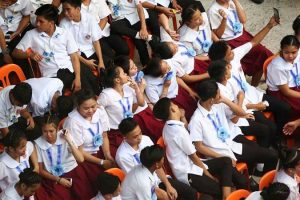THE EDUCATION department on Wednesday said they are open to allowing senior high school students to enter college before completing their final year of schooling, as officials look to streamline the curriculum amid concerns over redundancies.
The Department of Education (DepEd) could permit students to skip their final leg of schooling under the K-12 curriculum, Education Assistant Secretary Janir T. Datukan told a House of Representatives panel.
“Even without a law, can DepEd implement exit points after Grade 10 or Grade 11?” Pasig Rep. Roman T. Romulo, who heads the House Education committee, asked Education officials. “Can they proceed directly to college without taking Grade 12 anymore?”
“Yes,” Mr. Datukan said.
The Philippines implemented the K-12 curriculum in 2010 amid efforts to align the country’s education system on par with global standards. It added two additional years in high school and was meant to better align students with courses they plan to take up in college.
The Commission on Higher Education (CHED) and DepEd are also looking at adopting some of the General Education subjects taken in college under the senior high school curriculum to reduce redundancies in the Philippine education curriculum, Mr. Datukan said.
“The new proposal is to adopt the general education courses in our senior high school core subjects,” he said.
“They have already met and agreed that five of the remaining General Education subjects in college will be moved down to Senior High School, specifically to Grade 11,” Mr. Romulo told reporters after the House education panel hearing.
This could shave off a semester from college, said Mr. Romulo.
“You have already heard that CHED is open about the possibility of removing an entire semester from college,” he said.
CHILD DEV’T WORKERSMeanwhile, the Technical Education Skills Development Authority (TESDA) Board has approved the advanced training for Child Development Workers (CDWs) to improve the country’s early childhood education workforce, according to the Second Congressional Commission on Education (EDCOM 2).
“With the National Certification III for Early Childhood Care and Development, parents and guardians can be confident that our CDWs will gain the competencies needed to help children aged 0-4 in their holistic development,” said TESDA Secretary Jose Francisco B. Benitez said in a statement on Wednesday.
EDCOM 2 said that child development workers will undergo training and assessment under TESDA’s programs.
The new training will also cover the management of child development centers, assessments on the progress and development of children, and the implementation of the early childhood care and development curriculum.
In an EDCOM 2 report, it was found that only 16.8%, or 11,414 CDWs across the country had only completed high school. Around 89% of them remained in non-permanent positions, earning a monthly salary averaging P5,000.
“We have more than 68,000 CDWs nationwide, many of whom have not been given the tools, training, or compensation that will help them effectively perform their duties,” EDCOM 2 Co-Chairperson Senator Sherwin T. Gatchalian said.
“This certification is a crucial step toward their professionalization, which will improve both the delivery and quality of ECCD programs and services,” he added.
TESDA also launched a regional training program aimed at building a pool of qualified trainers at the regional level who can facilitate training programs for new regulations.
Moreover, Mr. Gatchalian pushed for a cost sharing initiative to address the lack of classrooms in local public schools.
“One effective strategy is implementing a counterpart program where local government units and the national government share the cost of constructing new classrooms,” he said in a separate statement.
DepEd earlier said that the backlog of classrooms in the country stood at 165,000 as it lacked the budget to construct more facilities. This was seen to impact the incoming 2025-2026 school year.
Under the 2025 budget, DepEd was given P28 billion for basic education facilities, including P7.18 billion for the construction of new kindergarten, elementary, and secondary school buildings. A P6.13-billion provision was allocated for rehabilitation and repair of schools.
“Solving the country’s classroom shortage demands a multi-faceted approach,” he added.
Mr. Gatchalian said that the government must also strengthen public-private partnerships and the Government Assistance to Students and Teachers in Private Education to help ease congestion in public schools.
“We need to be proactive in addressing these gaps. We must ensure that every student has a safe, secure, and appropriate educational space,” he added.
NEW ZEALAND SCHOLARSHIPS, RESIDENCYIn a separate development, New Zealand announced on Tuesday that more scholarships are open for Filipinos, along with an opportunity to pursue a possible long-term residency pathway after studying.
“We believe we have a strong understanding of motivations from students here in the Philippines,” Education New Zealand Manapou ki te Ao (ENZ) Regional Director for Asia Ben Burrowes told reporters in a briefing.
“So we can create an offering that best matches their interest, and we know their key interest are graduate outcomes,” he added.
In the 2024 data of ENZ, the Philippines was ranked the ninth largest source of international students in New Zealand. The government agency said that 56% of Filipinos were enrolled in applied learning and private training establishments (PTEs), followed by 27% in vocational training institutes.
To further increase the number of Filipino students abroad, the ENZ and 10 educational institutions will have an education roadshow for high school and undergraduate students, highlighting PTEs specializing in practical and hands-on courses.
The roadshow will have study fairs in Manila on May 31, Bacolod on June 3, and Cebu on June 7.
Apart from the roadshow, New Zealand Ambassador Catherine McIntosh announced more available slots for Filipinos in the Manaaki Scholarship Program opening in January 2026.
The Ambassador noted that the slots for Filipinos in 2026 rose to 44 from 16, which is the highest allocation for the country to date.
“It really is a significant increase in support of our foreign policy objectives in the region,” Ms. McIntosh said. “But also the comprehensive partnership which has been agreed to bilaterally between President Marcos Jr. and New Zealand Prime Minister Luxon.”
Aspiring Manaaki scholars are assessed based on leadership potential, development impact, and academic merit.
On its website, the scholarship grant is open to Filipino students applying for postgraduate studies. The recommended research study subjects for the candidates from the Philippines include climate change and environment, disaster management, renewable energy, food security and agriculture, and governance.
Scholars are required to return to their home country after graduation for the return service component for two years.
“More than academic merit and their articulation skills, the narrative by which their scholarship can rebound to their communities is a very important narrative for New Zealand’s scholarship program,” said New Zealand International Development Cooperation Manila Manager Dyan Mabunga Rodriguez.
ENZ also leverages digital campaigns for “green list” programs or study pathways that can possibly lead to long-term residency.
The green list programs, which include civil engineering, agriculture, and education, are industries in New Zealand that experience skill shortages.
“Say they’re studying agriculture, that’s currently a skill shortage in New Zealand,” Mr. Burrowes said. “If they’re wanting to stay beyond their post-study work rights, then they have a greater chance of obtaining the different visas that potentially could lead towards permanent residency.”
“We align the education goals with what our prospective international students are looking for and what our national skill shortages are,” he added.
From January to August 2024, New Zealand had 1,983 enrolled students from the Philippines. The ENZ said that the student visa approval rate in the same year reached 79%, which is a “strong” approval rate, according to Mr. Burrowes. — Kenneth Christiane L. Basilio, Adrian H. Halili, and Almira Louise S. Martinez


















